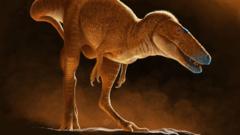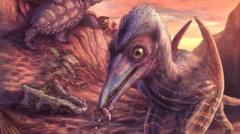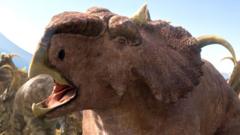The discovery of Khankhuuluu mongoliensis, from fossils in Mongolia, offers insights into the transition from small predators to giants like T. rex.
**New Tyrannosaur Ancestor Discovered, Shifting Understanding of Dinosaur Evolution**

**New Tyrannosaur Ancestor Discovered, Shifting Understanding of Dinosaur Evolution**
A newly identified species of dinosaur is reshaping our knowledge of the tyrannosaur family tree, indicating key evolutionary changes.
Researchers have unveiled a fascinating new addition to the dinosaur family tree that challenges previous notions of tyrannosaur evolution. The species, named Khankhuuluu mongoliensis, translates to "Dragon Prince of Mongolia," and has been identified from two 86-million-year-old skeletons found in a Mongolian museum. This species is now considered the closest known ancestor to all tyrannosaurs, including the famed T. rex.
The groundbreaking research, published in the journal Nature, signifies a pivotal point in understanding how tyrannosaurs evolved into formidable apex predators that dominated landscapes in North America and Asia until the dinosaurs' mass extinction. As described by Prof. Darla Zelenitsky of the University of Calgary, the term "Prince" highlights this species as an early, smaller member of the tyrannosauroid lineage, which comprises carnivorous dinosaurs that moved primarily on two legs.
The newly named Khankhuuluu mongoliensis represents a crucial evolutionary transition from its diminutive ancestors to the colossal predators that later emerged. PhD student Jared Voris, who spearheaded the research alongside Prof. Zelenitsky, elaborated on the distinguishing traits of these early tyrannosauroids, noting that they were once small, agile hunters navigating their environment while other larger predators occupied open spaces.
Weighing approximately 750 kg, Khankhuuluu mongoliensis provides an important link in the evolutionary chain leading to the evolution of massive species such as T. rex. "This transitional fossil helps us reevaluate the tyrannosaur family tree," added Zelenitsky. Key anatomical features observed in the species' skulls, such as advancements in the nasal bone structure, suggest the early development of the powerful jaws seen in later tyrannosaurs, enabling predatory behaviors like tackling larger prey and even biting through bone.
The two fossils examined in this study were initially categorized as Alectrosaurus when discovered in Mongolia during the 1970s. However, upon detailed examination, Voris recognized distinct features that warranted classifying it as a new species. "(Mr Voris) sent me a text indicating he believed he had found a new species," remarked Zelenitsky.
These findings also shed light on the mobility of tyrannosaurs between North America and Asia, facilitated by land bridges connecting Siberia and Alaska, which allowed the species to adapt and thrive in various ecological niches. "The migration between continents played a significant role in the evolution of diverse tyrannosaur groups," Voris noted.
Ultimately, Zelenitsky summarized the breakthrough well: "This discovery illustrates that before they became the kings of their era, tyrannosaurs were, in fact, princes."
The groundbreaking research, published in the journal Nature, signifies a pivotal point in understanding how tyrannosaurs evolved into formidable apex predators that dominated landscapes in North America and Asia until the dinosaurs' mass extinction. As described by Prof. Darla Zelenitsky of the University of Calgary, the term "Prince" highlights this species as an early, smaller member of the tyrannosauroid lineage, which comprises carnivorous dinosaurs that moved primarily on two legs.
The newly named Khankhuuluu mongoliensis represents a crucial evolutionary transition from its diminutive ancestors to the colossal predators that later emerged. PhD student Jared Voris, who spearheaded the research alongside Prof. Zelenitsky, elaborated on the distinguishing traits of these early tyrannosauroids, noting that they were once small, agile hunters navigating their environment while other larger predators occupied open spaces.
Weighing approximately 750 kg, Khankhuuluu mongoliensis provides an important link in the evolutionary chain leading to the evolution of massive species such as T. rex. "This transitional fossil helps us reevaluate the tyrannosaur family tree," added Zelenitsky. Key anatomical features observed in the species' skulls, such as advancements in the nasal bone structure, suggest the early development of the powerful jaws seen in later tyrannosaurs, enabling predatory behaviors like tackling larger prey and even biting through bone.
The two fossils examined in this study were initially categorized as Alectrosaurus when discovered in Mongolia during the 1970s. However, upon detailed examination, Voris recognized distinct features that warranted classifying it as a new species. "(Mr Voris) sent me a text indicating he believed he had found a new species," remarked Zelenitsky.
These findings also shed light on the mobility of tyrannosaurs between North America and Asia, facilitated by land bridges connecting Siberia and Alaska, which allowed the species to adapt and thrive in various ecological niches. "The migration between continents played a significant role in the evolution of diverse tyrannosaur groups," Voris noted.
Ultimately, Zelenitsky summarized the breakthrough well: "This discovery illustrates that before they became the kings of their era, tyrannosaurs were, in fact, princes."









